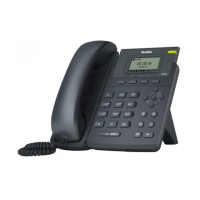Configuring Advanced Features
747
on the current screen, the execution of the action string
will be ignored. The menu item ID is case-insensitive.
Example: $Istatus_list& means entering the Status menu.
Note: To view the menu item ID, you can configure the
value of the parameter “edk.id_mode.enable” to 1
(Enabled) and then long press the Volume Up key when
the phone is idle.
$P<label>&C<characters
number allowed>&N&M$
The user input prompt string. Enable to prompt the
pop-up box, specify the label for the input box, specify the
maximum input characters, specify the character type for
the input box, and specify whether to mask the input by
the “*”.
“label” means the specified label for pop-up box.
“characters number allowed” defines the maximum
number of input characters.
If &N is included, the character type is Number (default
input method: 123). If &N is not included, the character
type is Text (default input method: abc), you can manually
change input method.
If &M is included, the input are masked by the “*”.
Example: $PEnter name&C3&N&M means prompting an
Enter name pop-up box, the maximum number of input
characters is 3, the input type is Number, and the input is
masked by the “*”.
$P<EDK prompt
X>N<characters number
allowed>$
This is a macro substitution string.
“EDK prompt X” means which EDK prompt is invoked. It
indicates the X defined by “edk.edkprompt.X.enable”.
“characters number allowed” defines the maximum
number of input characters. The user needs to press the
Enter soft key to complete data entry.
Example: $P2N5$ means invoking the EDK prompt 2 and
the maximum number of input characters is 5.
Note: For more information on EDK prompt, refer to
Configuring EDK Prompt on page 752.
This is the label for the entire operation. The value can be
any string including the null string (in this case, no label
displays).
This label is used if no label is configured for a custom key
or soft key, otherwise this one is ignored. Make this the
first entry in the action string.

